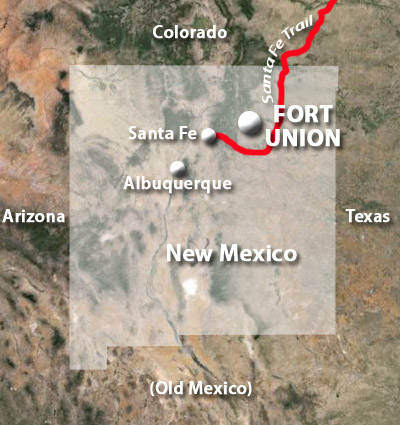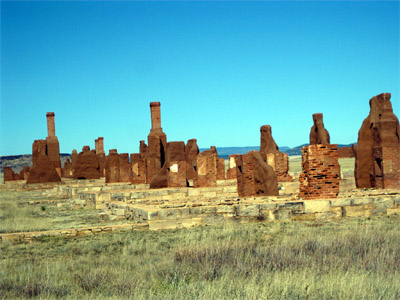 |
Fort Union
Watrous, New Mexico
|
|
 |
Constructed: 1861
Used by: USA
Conflict in which it participated:
US Civil War
|
Today little more than a series of ruined walls and the remains of chimneys pointing to the sky, Fort Union was once the only Federal outpost protecting the southern reaches of the Santa Fe Trail.
In the 16th century, Spaniards making inroads into the New World, specifically in what is now the southwestern United States, were pleased to find an ancient Indian trail that led hundreds of miles into the continent. Spaniards used what would become known as the Santa Fe Trail to explore this new land, making contact and trading with the Plains Indians. In the 18th century the Indians began to do business with French traders in the Mississippi Valley, despite Spanish laws against it. |
 |
 |
|
After the US bought the Louisiana Territory from France in 1803, explorers found the route and discovered, in what is now New Mexico, an isolated area that was just starving for stuff America could produce. Spain continued to officially block trade with the alarmingly growing US, but Mexico was about to throw off its Spanish shackles.
|
Fort Union, back when the world was still black and white. And filled with carts 'n' wheels-a-plenty. |
 |
Hot on the heels of the Mexican War of Independence (1810-1821), Virginia freight operator and veteran of the War of 1812 William Becknell (1788-1856) was the first to saddle up in Franklin, Missouri and deliver a load of consumer goods to Santa Fe, Mexico. Freight traveled in both directions, and the Santa Fe Trail was suddenly the one and only commercial connection betwixt Mexico and the US.
Mexico was no doubt pleased that it had agreed to the development of this route in 1846, when the Santa Fe Trail was used by the US Army as a major invasion route of the Mexican-American War (1846-1848). |
|
|
The war helped to achieve the expansion of the US to the Pacific. Though the Santa Fe Trail was now completely in US hands, it remained a dangerous route to travel, thanks to increasing (and entirely unprovoked) Indian unrest in the region.
Which finally brings us to Fort Union! The first Fort Union, built in 1851 to protect folks on the Santa Fe Trail, had the appearance of a quiet frontier settlement more than that of a military fortification.
|
The fort's mounted troops patrolled the Santa Fe Trail, and soon were providing escorts for mail stages. Wagon trains generally provided for their own defense, but the US Civil War (1861-1865) brought new dangers.
Information as to precisely when the next two iterations of Fort Union were built is sketchy, but by 1861 the fort was on its third and final version, the largest fortification in the southwest US...the ruins of which are what we see in the picture at the top of this page. It was obviously a lovely, classic four-bastioned starfort design, with ravelins protecting each of its curtain walls.
|
 |
Fort Union today. One can imagine a National Park Service Ranger, while preparing the fort for visitors, bellowing, "Wheels! We need more wheels!!" |
|
Fort Union wasn't built with the stoutness needed to hold out against an assaulting force armed with big guns, so its walls would have been relatively thin: 'Twas more a base of operations for cavalry, and a protected place in which locals to huddle in the event of bloodthirsty Indian attack.
A battalion-sized Confederate force headed into New Mexico Territory in 1862, aiming to seize portions of the Santa Fe Trail and the Colorado goldmines. Confederate incursions into New Mexico were repulsed, however, and heavy patrolling and escorting duties by the garrison at Fort Union kept the trail open.
|
 What's left of the many soldiers' barracks: Chimneys, serving as mute testimony that it does get cold in the desert. |
 |
Interestingly, when the site for Fort Union was selected in 1851, nobody noticed that it was on private property. Fort Union was built on the Mora Grant, which was the property of a private individual named Jose Tapia. The grant had been made by New Mexico Governor Albino Perez in 1835, and once Jose noticed that a fort had been built on his land, he challenged the US government in court. The case percolated for decades, until in 1876 the Surveyor-General of New Mexico had an official look and said, "Yep! This fort is on the Mora Grant, all right!" The government stalled the proceedings until the fort had lost its usefulness and was abandoned, without ever having paid the claimant for use of his land. |
|
|
Most American starforts were done in by the advent of modern, rifled guns and the aeroplane: Fort Union was killed by the train. In the 1870's, the railroad was making its inexorable creep into the region, destroying all before it: By 1879 rail lines passed Fort Union, making it entirely unnecessary. The fort was closed in 1883.
Fort Union was declared a National Monument in 1956.
|
|
|
|
|
|
 |




